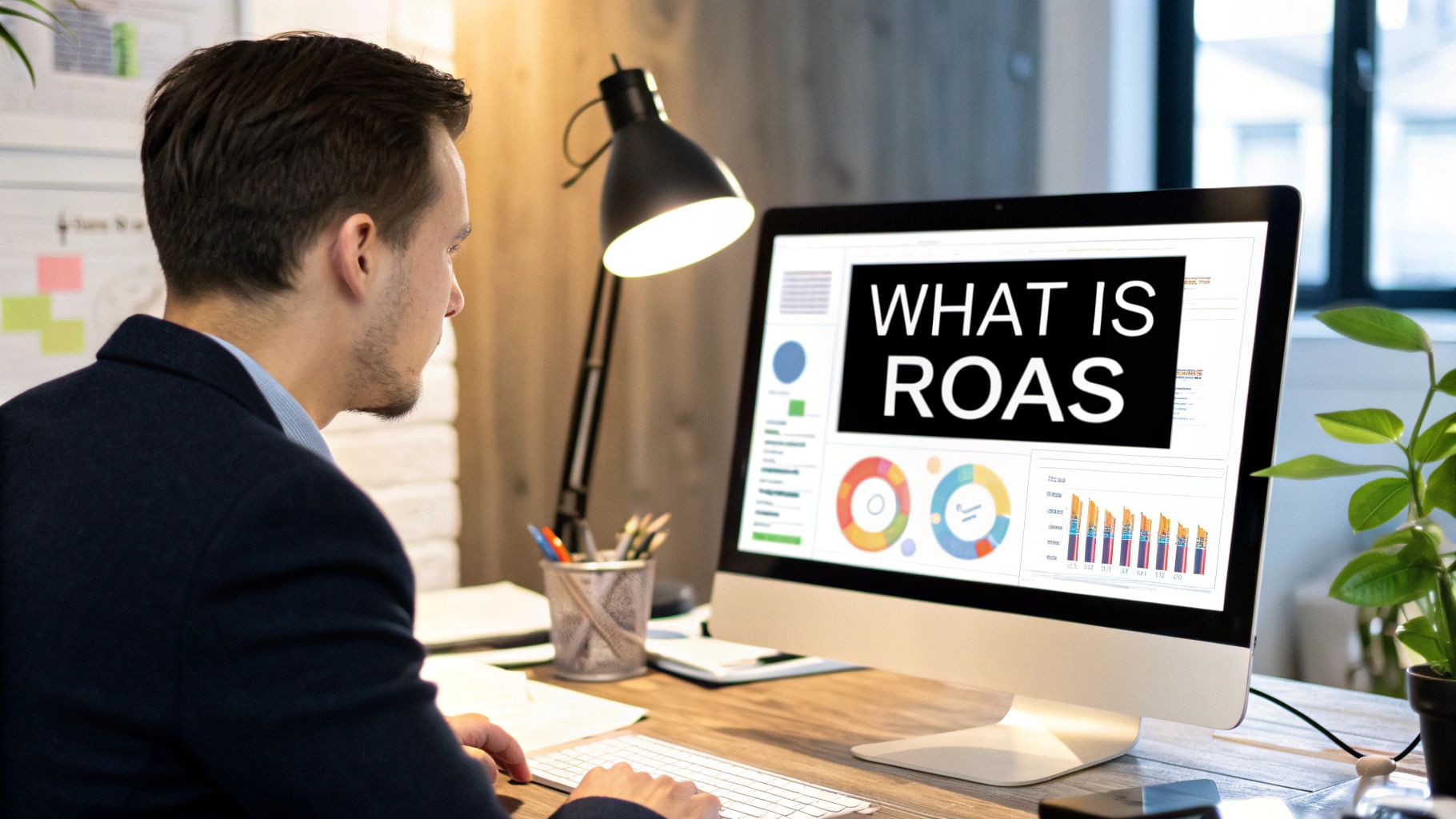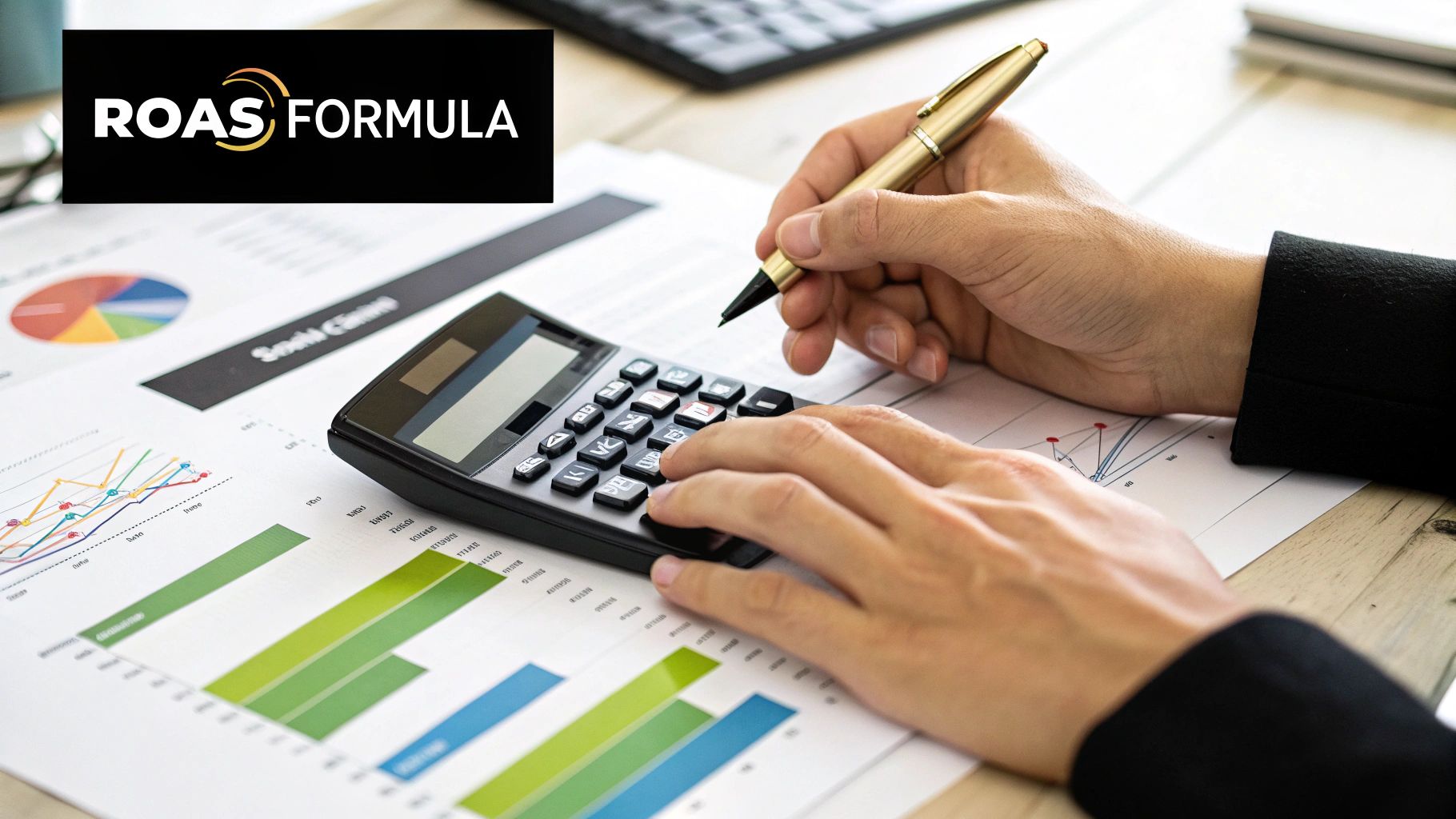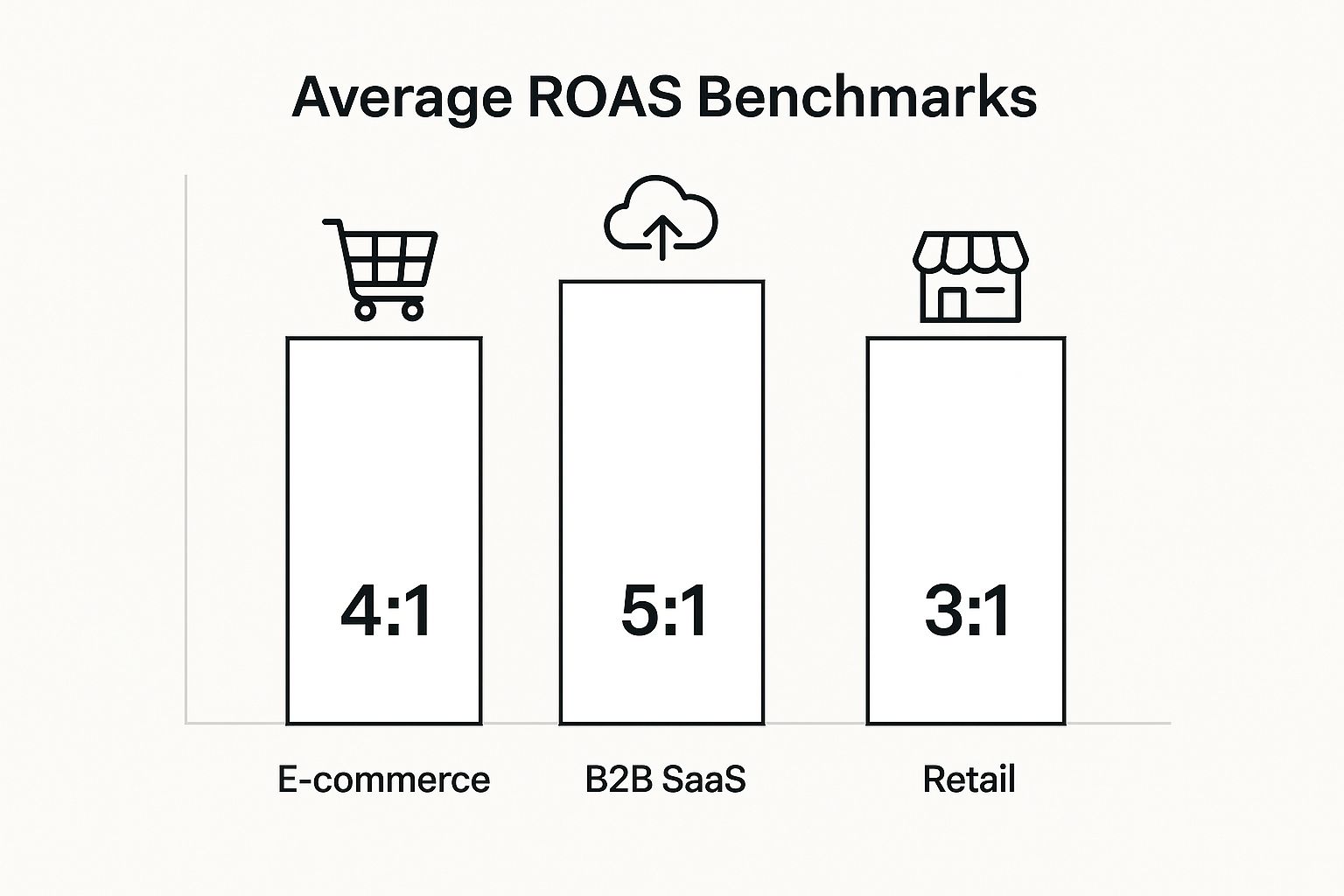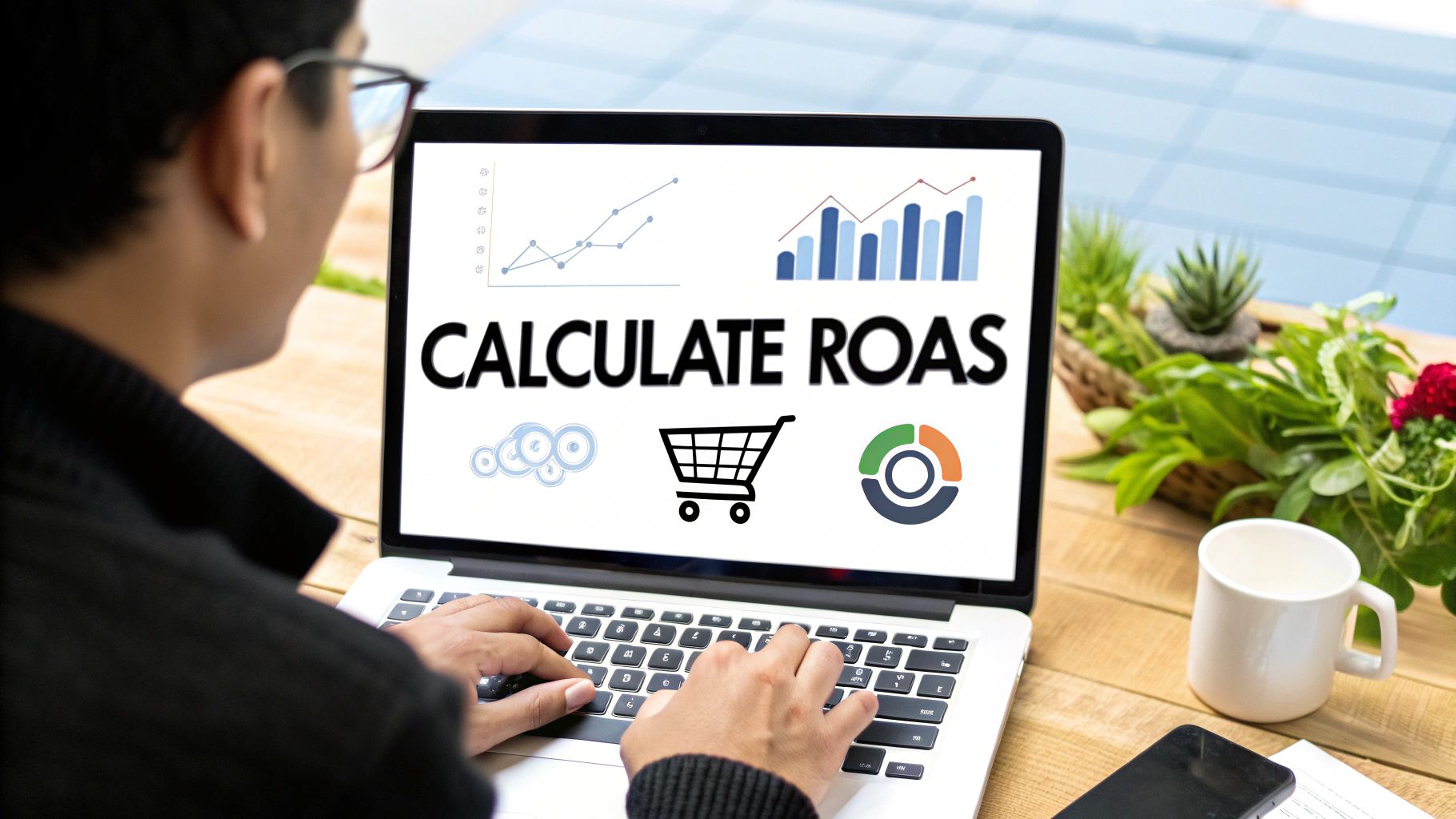You're pouring money into Meta and Google ads. But are they actually making you any money? This is a question that keeps every e-commerce founder up at night.
The answer is found in one surprisingly simple metric. To figure out your return on ad spend (ROAS), you just divide the total revenue your ads generated by your total ad cost. It’s that straightforward. A 5:1 ROAS means for every $1 you spend, you get $5 back in sales.
In this playbook, you'll learn exactly how to calculate return on ad spend accurately, what a "good" ROAS really looks like for your business, and the actionable strategies we use with our clients to improve it.
Your Guide to Return on Ad Spend

Let's cut through the noise. You don't need a finance degree to see if your marketing is pulling its weight. At its heart, calculating ROAS is all about measuring how effective your advertising really is. It gives you a direct, tactical answer to a crucial question: "Is this specific ad campaign bringing in more money than it costs?"
From our experience with over 500 Shopify stores, this is where so many brands stumble. They either track the wrong numbers or, worse, don't track them at all. They’re essentially flying blind. This isn't just a missed opportunity; it's a fast track to burning cash on campaigns that feel busy but do nothing for your bottom line.
The ROAS Formula: What Really Goes Into It
Getting this right means being brutally honest about what counts as "Revenue" and "Ad Cost." A common mistake we see is brands using gross revenue without factoring in discounts, or only counting the platform spend while conveniently ignoring agency fees. This gives you an inflated ROAS and a false sense of security.
To make sure your numbers are accurate, it's critical to know precisely what to include and what to leave out. This quick-reference table breaks it down.
The Core Components of the ROAS Formula
Getting your inputs right is the difference between a vanity metric and a real business KPI.
According to Statista, digital channels now make up a huge portion of global ad spend, so accurately tracking this has never been more important.
But remember, ROAS only tells part of the story. It’s a snapshot of immediate campaign efficiency, not the long-term health of your business. It doesn't capture the future value of the customers you acquire. For a more complete picture, you should also consult a guide to Lifetime Value Calculation (LTV) in SaaS. LTV shows you the true long-term return on that initial ad investment.
So, what's the magic number? What ROAS should you actually be aiming for? If anyone gives you a single, definitive answer like "aim for a 4:1," you should be immediately skeptical.
The honest answer we always give our clients is this: it depends.
Having worked with hundreds of Shopify stores, we've seen brands thrive on a 3:1 ROAS while others have gone out of business with a 6:1. A generic benchmark is pretty much useless because it completely ignores the one factor that matters most: your profit margin.
Think about it. A luxury watch brand with a fat 70% profit margin can be wildly profitable with a 3:1 ROAS. But a fast-fashion brand scraping by on a slim 20% margin might need an 8:1 ROAS just to see a penny of profit after all costs are factored in.
First, Find Your Break-Even ROAS
Before you can even think about setting a target, you have to know your floor. Your break-even ROAS is the point where you aren't making money, but you aren't losing it either. It’s the minimum ROAS needed to cover both the cost of your product and the cost of the ads themselves.
The formula is beautifully simple:
Break-Even ROAS = 1 / Profit Margin
Let's ground this in a real-world example. Imagine you sell a product for $100.
- If your profit margin is 50% (meaning your total cost of goods is $50), your break-even ROAS is 1 / 0.50 = 2:1. For every $1 you spend on ads, you need to make $2 in revenue just to cover your costs.
- But if your margin is only 25% (costing you $75), your break-even ROAS jumps to 1 / 0.25 = 4:1. Suddenly, the bar is set much, much higher.
This calculation is the non-negotiable starting point for any intelligent ad strategy. It strips away emotion and guesswork, replacing it with cold, hard financial reality. To get your own number in a few seconds, you can use our simple ROAS break-even calculator and set a clear baseline for your campaigns.
Moving From Break-Even to a Healthy Target ROAS
Once you know your break-even point, you can finally set a realistic target ROAS. This is the number that ensures you're not just staying afloat, but actually generating a healthy profit you can reinvest back into growing the business.
A good rule of thumb we advise our clients is to aim for a target ROAS that is at least double their break-even point.
- That brand with 50% margins and a 2:1 break-even? A healthy target for them would be 4:1 or higher.
- And the brand with 25% margins and a 4:1 break-even? They need to be shooting for 8:1 or more to make it worthwhile.
This approach grounds your advertising goals in the unique financial health of your store. It shifts the entire conversation from "What ROAS is good?" to "What ROAS is good for my business?" This is how you build a sustainable, profitable advertising engine that actually fuels growth instead of just draining your bank account.
How to Uncover Hidden Costs That Kill Your ROAS

One of the most common mistakes we see brands make is looking at their Meta Ads Manager, seeing a 5:1 ROAS, and popping the champagne. But that number, more often than not, is a lie.
The reality is that your true advertising cost is so much more than what you pay the ad platform directly. It’s the hidden costs—the ones lurking just beneath the surface—that quietly eat away at your profits and turn a seemingly great campaign into a financial drain.
To get an honest answer on your performance, you have to account for every single dollar that goes into supporting your advertising. Think beyond the platform spend. What about your agency’s retainer? The freelancers you hired for creative? The salaries of your in-house marketing team? These are all direct costs of running your ads.
With the precision digital advertising offers, your measurement is only as good as the numbers you put in. If you ignore the associated costs, you're just looking at an inflated, vanity metric—not true profitability.
A Real-World Example of Misleading ROAS
Let me share a story about a fast-growing DTC brand we started working with. They were thrilled with their 5:1 ROAS on a $10,000 monthly ad spend, which was pulling in $50,000 in revenue. On paper, it looked like they were crushing it.
But when we started digging, the picture changed dramatically.
The Problem: Their calculation was dangerously incomplete. They were completely ignoring thousands of dollars in expenses directly tied to making those ads work.
Here’s what was missing from their "Ad Cost" calculation:
- Agency Fee: $3,000/month to manage their campaigns.
- Creative Production: $1,500/month for a freelancer to create ad videos and images.
- Software Subscriptions: $500/month for various analytics and design tools.
So, their true ad cost wasn't $10,000; it was actually $15,000. Once we recalculated with the real numbers ($50,000 Revenue / $15,000 True Cost), their ROAS plummeted from a stellar 5:1 to a much more sobering 3.3:1.
This single insight changed their entire strategy, forcing them to re-evaluate their agency relationship and creative budget. And while ROAS focuses on the ad spend side, don't forget that post-sale issues can chip away at your revenue. For a full financial picture, it’s worth understanding the impact of e-commerce chargebacks as well.
Your True Ad Cost Checklist
To avoid this common trap, you need to be absolutely meticulous. This isn't just about getting an accurate ROAS; it’s about truly understanding your marketing efficiency. For a broader look at that, check out our guide on how to calculate marketing ROI, which zooms out to view overall profitability.
Use this checklist to make sure you're capturing every relevant expense:
- Platform Spend: The obvious one—what you pay directly to Meta, Google, TikTok, etc.
- Management Costs: Agency retainers, freelancer fees, and the pro-rated salaries of your internal team members working on the ads.
- Creative Costs: Any payments for graphic design, video production, photography, and copywriting.
- Software & Tooling: Subscriptions for any analytics, reporting, or automation tools that support your ad campaigns.
- Affiliate & Influencer Payouts: Any commissions you pay out for sales that were attributed to your ad campaigns.
Solving Attribution Challenges to Understand True Value
Is last-click attribution giving you the full picture of your ad spend's return? From our experience with over 500 Shopify stores, it's almost certainly not. Relying solely on what a customer clicked right before buying is one of the most common—and costly—mistakes a brand can make.
Think about it. Today’s customer journey isn't a straight line. It’s a winding path across multiple touchpoints—a social media ad they saw last week, a blog post they read yesterday, a quick Google search, and maybe even a chat on WhatsApp. When you only credit that final click, you completely ignore all the hard work your other marketing did to get them there in the first place.
Moving Beyond Last-Click
To get a true sense of your marketing impact, you need a clearer view of the entire customer journey. Different attribution models assign value to various touchpoints, and figuring out which ones work for you is key to making smarter budget decisions. It's not about finding one "perfect" model, but about using the right tool for the right job.
For instance, you could use one model for your top-of-funnel awareness campaigns and another for your bottom-funnel conversion ads. Blending them gives you a much more honest picture.
Choosing the Right Attribution Model
Picking an attribution model can feel complicated, but it's really about aligning the model with your campaign goals. This table breaks down the most common models to help you decide which one makes the most sense for what you're trying to measure.
Ultimately, the goal is to use a mix of these models to get a complete, accurate picture of what's actually driving sales. It's about giving credit where credit is due.
While benchmarks vary, this infographic gives you a feel for the average ROAS across different industries.

As you can see, what counts as a "good" ROAS can differ significantly. This just reinforces why you need attribution models that can actually capture the unique customer journey in your specific sector.
Capturing Revenue Hidden from Traditional Analytics
Here’s where things get really interesting, especially for e-commerce brands. There’s a massive blind spot in most analytics setups: revenue generated after the click, particularly in conversational channels.
Imagine this scenario: a customer clicks your Meta ad, browses your site, but only decides to buy after getting a quick question answered on WhatsApp. Where does that sale get credited?
Most analytics platforms will chalk that up to "Direct Traffic" or miss it entirely. The ad that started the whole conversation gets zero credit, tanking its perceived ROAS.
As an official Meta Business Partner, we built Kanal to solve this exact problem. By integrating directly with your Shopify store, Kanal tracks sales that happen inside a WhatsApp conversation and correctly attributes them back to the original ad campaign. This means you capture revenue that was previously invisible.
Suddenly, you have a much more accurate ROAS and concrete proof of conversational commerce's value. You’re no longer guessing if your ads are leading to sales through chat—you’re seeing it happen.
Actionable Strategies to Improve Your ROAS

So, you’ve got a handle on how to calculate return on ad spend and you know what a good target looks like. That's the easy part. The real question is, how do you actually move the needle?
This is where the rubber meets the road. The strategy that consistently delivers the best results for our clients goes way beyond just tinkering with ad creative. It’s about squeezing every last drop of value from the traffic you're already paying for.
After working with hundreds of Shopify stores, we can tell you the single biggest leak in most marketing funnels is the post-click experience. You spend good money to get someone to your site, but what happens after they land? That's your moment of truth.
This is precisely why integrating a tool like WhatsApp into your funnel can be so powerful. You're not just getting a click; you're starting a conversation and building a relationship, which is how you turn decent ROAS into great ROAS.
Turn Ad Clicks into WhatsApp Conversations
Think about this common scenario: someone sees your Meta ad, clicks through to your product page, and then... they hesitate. Maybe they're unsure about sizing, have a question about shipping times, or want to know about the material.
Most brands just let these potential customers walk away, hoping they'll remember to come back later. That’s like throwing away perfectly good ad dollars.
Instead, you can engage them right in that moment of hesitation. By adding a simple "Chat on WhatsApp" button to your ads or product pages, you give them a direct, low-friction way to get answers. The moment they send that first message, you've captured a high-intent lead on a platform that boasts an incredible 98% open rate.
From there, a simple Kanal flow can take over, instantly answering their common questions and nudging them toward checkout. This one tactic salvages countless clicks that would otherwise go to waste, directly boosting the revenue from your existing ad campaigns.
Recover More Abandoned Carts from Ad Traffic
Here’s another incredibly effective strategy we see our clients use every day. A shopper clicks your ad, adds an item to their cart, but then life gets in the way and they bounce.
Standard abandoned cart emails are okay, but they typically only recover about 15-20% of carts. WhatsApp, on the other hand, is a different beast entirely.
Using Kanal, you can trigger an automated abandoned cart message on WhatsApp just minutes after they leave. We often recommend a simple, disarming template like this:
Hey [Customer Name]! 👋 We noticed you left some amazing items in your cart from [Your Brand]. Did you have any questions before they sell out? We're here to help!
This feels less like aggressive marketing and more like helpful, personal service. By recovering just a handful of extra carts each day from your paid traffic, you are directly increasing the "Revenue" side of your ROAS formula without spending a single cent more on ads.
Increase Lifetime Value to Boost Blended ROAS
Don't make the mistake of thinking your ROAS calculation ends after that first purchase. The most successful brands we work with are obsessed with the Lifetime Value (LTV) of the customers they acquire. We've seen clients increase their LTV by 20-30% in just a few months with the right post-purchase strategy. This is the secret to a healthy blended ROAS over the long term.
Once a customer buys, you have their permission to stay in touch. This is your green light to use Kanal for smart, post-purchase marketing that keeps them coming back.
- Smart Cross-sells: "Loved that dress? Here are the perfect shoes to go with it!"
- VIP Welcome Offers: "As a thank you for your first order, here's 15% off your next one."
- Timely Replenishment Reminders: "Looks like you might be running low on your favorite serum. Time for a restock?"
Every single one of these follow-up purchases adds to the total return from that initial ad spend. Truly understanding how to increase customer lifetime value is non-negotiable for sustainable growth. Ultimately, improving these core customer engagement metrics is what turns a good advertising strategy into an unbeatable one.
Common ROAS Questions Answered
Working with brands every day, we hear the same questions about ROAS time and time again. So let's cut through the confusion and give you the clear, practical answers we share with our clients. These are the kinds of details that separate brands just spending money from those that are truly investing.
How Often Should I Calculate My ROAS?
This is a classic, and the honest answer is: it depends on what you're trying to figure out. There isn't a single magic number.
For active campaigns: You'll want to be in there checking your ROAS at least weekly. This gives you enough real data to spot trends and make smart tweaks—like shifting budget to a winning ad set or killing a dud creative—without getting spooked by normal daily ups and downs.
For the big picture: You need to zoom out and do a more comprehensive ROAS analysis monthly or quarterly. This is where you pull in all the hidden costs and look at your overall marketing strategy. This rhythm helps you make informed decisions about where your marketing dollars should go next.
What Is the Difference Between ROI and ROAS?
This is a crucial one. We see people mix these up all the time, and it can lead to some seriously flawed financial thinking.
ROAS (Return on Ad Spend) is purely a campaign metric. It's laser-focused on the gross revenue you generate for every dollar you put into advertising. It answers one simple question: "Is this ad pulling its weight?"
ROI (Return on Investment) is a business metric. It looks at your total profit after you subtract all your costs—not just ads, but your Cost of Goods Sold (COGS), shipping, salaries, and everything else. It answers the much bigger question: "Is this entire venture actually making us money?"
Here's the thing: you can have a stellar 4:1 ROAS and still have a negative ROI if your product margins are razor-thin. ROAS tells you if your ads are efficient; ROI tells you if your business is profitable. You need to track both.
My ROAS Is Low. What Should I Check First?
Okay, so the numbers look grim. Don't panic and kill the campaign just yet. From our experience in the trenches, the problem is almost always hiding in one of these three places.
Your Ad & Targeting: Is your creative actually connecting with people? Or is your targeting way too broad? A low click-through rate (CTR) is often the smoke detector for a fire in this area.
Your Landing Page Experience: You can have the best ad in the world, but if it sends people to a slow, confusing, or clunky mobile page, you're just burning cash. A high CTR paired with a low conversion rate is a massive red flag pointing directly at your landing page.
The Offer Itself: Step back from the ad for a second. Is the product compelling? Is the price point right for the audience you're targeting? Could your shipping costs be scaring people away at the last second? Sometimes, a tiny tweak to the offer itself is all you need to turn things around.
Start your troubleshooting there. Focusing on these three areas helps you find the biggest leaks in your advertising funnel first. A great ROAS is also tied to a great customer journey. You can dig deeper into this by learning how to measure customer satisfaction, because happy customers are the ones who actually convert.
In summary, knowing how to calculate return on ad spend is about more than just a formula; it's about understanding the true profitability of your marketing. By calculating your break-even ROAS, accounting for all hidden costs, and using conversational tools to increase conversions and LTV, you can build a truly efficient growth engine.
Ready to see how conversational marketing can boost your ROAS? Get a demo of Kanal today and see these strategies in action.



